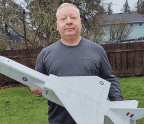FUNCTIONAL SCALE RIGGING

Before the 1930s, it was common for full-size aircraft to feature various forms of rigging wires and support struts to maintain structural integrity. Today, rigging is more commonly found in both experimental class homebuilt planes and light aircraft. This feature has also transitioned into the scale RC world, and chances are that if the full-size aircraft needed them, so does your model! Let’s look at a few examples.
There are conventional high-wing airplanes like the Piper J-3 Cub and Pilatus Porter, where struts are used to connect the wing to the fuselage, and all for good reason. Without the wing struts, the wing can break off in flight. In the case of biplanes, interplane struts are designed to attach the upper wing to the lower wing; they are often located close to the outer wing panels. Then, the cabane struts connect the upper wing to the fuselage and the wing rigging (often referred to as “flying wires”),
You’re reading a preview, subscribe to read more.
Start your free 30 days



